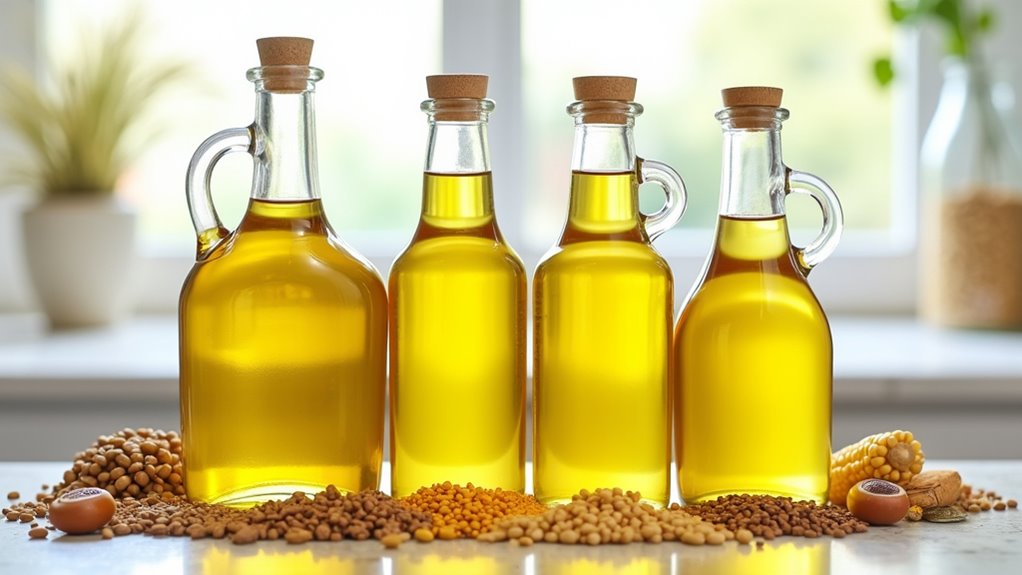Seed oils are plant-derived fats extracted from seeds through mechanical pressing or chemical solvents. You’ll encounter common varieties like canola, soybean, and sunflower oils in processed foods and cooking applications. While these oils offer certain nutritional benefits, their industrial production processes and high omega-6 content have raised health and environmental concerns. Traditional alternatives like olive oil, coconut oil, and ghee provide different fatty acid profiles and processing methods. Understanding the intricacies of seed oils will equip you to make informed dietary choices.
What Are Seed Oils? Defining the Most Common Types

Seed oils, also known as vegetable oils, are fats extracted from the seeds of diverse plants through mechanical pressing or chemical processing. The most common types include canola oil (from rapeseed), soybean oil, sunflower oil, safflower oil, and grapeseed oil.
You’ll find these oils offer varying nutritional benefits and culinary uses based on their unique compositions. Canola oil contains high levels of monounsaturated fats and omega-3 fatty acids, while sunflower oil is rich in vitamin E. Soybean oil provides essential omega-6 fatty acids and serves as a versatile cooking medium.
Each oil exhibits distinct smoke points, affecting their suitability for different cooking methods. For example, refined safflower oil’s high smoke point makes it ideal for high-heat cooking, while unrefined grapeseed oil works better for dressings and low-heat applications.
The History and Rise of Industrial Seed Oil Production
The extraction of seed oils dates back to ancient civilizations using simple mechanical presses and mortar-and-pestle techniques to crush oilseeds. You’ll find the initial major shift in production occurred during the Industrial Revolution when steam-powered hydraulic presses enabled manufacturers to process larger quantities of seeds more efficiently. The real transformation came in the early 1900s with the development of chemical solvents and high-heat extraction methods, which dramatically increased yields and made seed oils commercially viable on a global scale.
Early Mechanical Extraction Methods
Early mechanical extraction of oils relied on three fundamental processes that shaped industrial production throughout the 19th century. You’ll find that historical techniques centered around cold pressing, which preserved the oil’s nutritional qualities while minimizing oxidation. The process involved crushing seeds between heavy stone or metal plates to release their oils.
Key developments in mechanical extraction included:
- The hydraulic press (1795) – revolutionized extraction efficiency
- The screw expeller (1870s) – enabled continuous processing
- The cage press system – improved yield rates markedly
- The roller mill design – standardized crushing techniques
These innovations transformed seed oil production from small-scale operations to industrial-level manufacturing. The mechanical methods you’d encounter in early facilities primarily focused on maximizing extraction rates while maintaining oil quality through controlled pressure and temperature management.
Mass Production Takes Hold
During the early 20th century, rapid industrialization and technological advances fundamentally transformed seed oil production into a large-scale manufacturing process. You’ll find that chemical solvents, particularly hexane, replaced traditional mechanical pressing methods, enabling manufacturers to extract up to 99% of available oils from seeds. This development dramatically increased production efficiency and reduced costs.
The advent of continuous-flow processing systems and automated bottling lines in the 1940s further accelerated mass production capabilities. While these innovations made seed oils more accessible and affordable, they’ve also sparked sustainability concerns due to intensive farming practices and chemical usage. Today, growing consumer awareness has led to increased scrutiny of industrial extraction methods, prompting some manufacturers to investigate alternative processes that balance efficiency with environmental impact.
Modern Manufacturing Transforms Industry
Modern manufacturing techniques revolutionized seed oil production between 1950-1980, introducing automated systems that could process over 1,000 tons of seeds per day. You’ll find that computerized monitoring and quality control systems transformed what was once a labor-intensive process into a highly efficient operation.
Key advancements in manufacturing include:
- Continuous-flow solvent extraction methods that increased yield by 50%
- Advanced filtration systems that removed impurities more effectively
- Automated packaging lines that reduced contamination risks
- Real-time quality monitoring through spectroscopic analysis
These innovations haven’t just improved efficiency; they’ve also enabled better sustainability practices through reduced waste and energy consumption. As consumer awareness grows, manufacturers have implemented stricter quality controls and traceability systems. Today’s seed oil facilities integrate advanced analytics and automation to maintain consistent quality while meeting increasing global demand.
How Seed Oils Are Manufactured: From Plant to Bottle
The manufacturing process for seed oils involves multiple industrial steps that transform raw plant materials into refined cooking oils. You’ll find that modern seed extraction begins with cleaning and preparing the raw seeds, followed by mechanical pressing or chemical solvent extraction using hexane to optimize oil yield.
After initial seed extraction, the crude oil undergoes extensive refinement processes. These include degumming to remove phospholipids, neutralization to eliminate free fatty acids, bleaching to improve color, and deodorization to remove volatile compounds. Throughout refinement, the oil is exposed to high temperatures and chemical treatments that alter its molecular structure.
The final steps involve cooling, filtering, and bottling the refined oil. Quality control measures guarantee the product meets industry standards for clarity, stability, and shelf life before distribution.
The Chemical Composition of Seed Oils

Seed oils primarily consist of triglycerides, molecules formed by three fatty acid chains attached to a glycerol backbone. The fatty acid composition varies greatly among different seed oils, directly impacting their oil stability and functional properties.
The molecular structure of seed oils – triglycerides with three fatty acid chains – defines their unique properties and stability characteristics.
When you examine seed oils at a molecular level, you’ll find:
- Saturated fatty acids with no double bonds, providing stability but solidifying at room temperature
- Monounsaturated fatty acids with one double bond, offering moderate stability and remaining liquid
- Polyunsaturated fatty acids with multiple double bonds, being less stable and prone to oxidation
- Minor components like tocopherols and phenolic compounds that act as natural antioxidants
The ratio of these fatty acids determines the oil’s susceptibility to rancidity, smoke point, and overall shelf life, making each seed oil distinctly suited for specific culinary applications.
Health Claims vs. Scientific Evidence
Understanding a seed oil’s molecular composition helps explain why multiple health claims about these oils often conflict with available scientific evidence. You’ll find that while some manufacturers promote heart health benefits, scientific research shows mixed results. Studies published in peer-reviewed journals indicate that the high omega-6 content in most seed oils may contribute to inflammatory responses in some individuals.
When you evaluate nutritional concerns, you’ll need to examine both processing methods and fatty acid ratios. Clinical trials suggest that cold-pressed seed oils retain more beneficial compounds than heavily processed versions. However, the evidence linking seed oil consumption to specific health outcomes remains inconclusive. Research continues to investigate how different extraction methods, storage conditions, and cooking temperatures affect these oils’ potential benefits and risks.
The Link Between Seed Oils and Inflammation

While research on seed oils remains complex, emerging evidence suggests a correlation between their consumption and inflammatory responses in the body. When you consume high amounts of seed oils, you’re potentially increasing your body’s inflammation markers, which may contribute to diverse chronic diseases.
Studies have identified several mechanisms linking seed oils to inflammation:
Emerging scientific research reveals multiple pathways through which seed oils may trigger inflammatory responses within the human body.
- Excessive omega-6 to omega-3 ratios can disrupt your body’s inflammatory response
- Oxidation of polyunsaturated fats during processing may create harmful compounds
- High levels of linoleic acid might interfere with cellular signaling pathways
- Regular consumption could lead to accumulation of oxidized lipids in tissues
Research indicates that monitoring your seed oil intake might help manage inflammation levels. Scientists continue investigating the relationship between specific seed oils and their impact on inflammatory biomarkers, particularly in individuals predisposed to chronic diseases.
Traditional Cooking Oils: Natural Alternatives
For those seeking healthier cooking options, several traditional cooking oils offer scientifically-validated alternatives to processed seed oils. You’ll find that extra virgin olive oil contains high levels of polyphenols and monounsaturated fats, while coconut oil provides medium-chain triglycerides (MCTs) that support metabolic health. Avocado oil stands out for its high smoke point and oleic acid content.
Traditional fats like ghee butter and animal fats (tallow, lard) deliver fat-soluble vitamins and stable cooking properties. Palm oil, when sustainably sourced, offers vitamin E and carotenoids. Different nut oils, including macadamia and walnut, provide unique flavor profiles and beneficial omega-3 fatty acids. These traditional cooking oils have withstood centuries of use and modern scientific scrutiny, demonstrating their value in heat-stable cooking applications and nutritional benefits.
Reading Labels: Identifying Hidden Seed Oils
Guiding through food labels often reveals hidden seed oils lurking in unexpected products. Through careful label reading, you’ll uncover that manufacturers frequently use alternative names for common seed oils, making ingredient awareness essential for informed choices.
- Look for terms like “vegetable oil blend,” “shortening,” or “modified palm oil,” which often indicate processed seed oil presence
- Check ingredient lists thoroughly, as seed oils may appear under scientific names like “partially hydrogenated soybean oil”
- Watch for phrases containing “modified,” “refined,” or “fractionated,” suggesting processed seed oil derivatives
- Examine condiments, dressings, and baked goods carefully, as these frequently contain concealed seed oils
When investigating packaged foods, you’ll need to scrutinize both front and back labels, as marketing terms like “natural” or “heart-healthy” don’t necessarily indicate seed oil absence.
The Environmental Impact of Seed Oil Production
Beyond knowing what’s in your food, understanding seed oil production’s environmental footprint reveals a complex web of ecological challenges. You’ll find that large-scale monocropping for seed oils contributes considerably to biodiversity loss and habitat destruction.
| Impact Factor | Environmental Consequence |
|---|---|
| Land Use | Deforestation & soil degradation |
| Water Resources | High consumption & pollution |
| Chemical Inputs | Pesticide runoff & soil toxicity |
Major sustainability concerns arise from intensive farming practices required for seed oil crops. You’re looking at substantial water usage, with some crops requiring up to 1,000 gallons per pound of oil produced. Chemical fertilizers and pesticides further compound environmental damage, leading to soil degradation and waterway contamination. When you consider these factors, it’s clear that current seed oil production methods pose considerable threats to ecosystem health.
Making Informed Choices: Shopping and Cooking Tips
When maneuvering through the vast selection of cooking oils at your local market, you’ll need to evaluate several key factors to make the best choices. Your shopping strategies should align with your intended cooking techniques and storage capabilities.
To optimize your seed oil selection, consider these critical factors:
- Check the smoke point rating – higher temperatures require oils with higher smoke points
- Examine the processing method – cold-pressed oils retain more nutrients
- Verify the “best by” date and packaging material – dark glass bottles protect against oxidation
- Review the fatty acid profile – match it to your cooking techniques
Store your oils away from heat and light to prevent rancidity. For high-heat cooking techniques like stir-frying, choose oils with smoke points above 400°F (204°C). For dressings and low-heat applications, cold-pressed varieties offer superior flavor profiles.
Frequently Asked Questions
Can Seed Oils Be Used for Purposes Other Than Cooking?
You’ll find seed oil uses extend far beyond the kitchen. They’re valuable in industrial applications like biodiesel production, lubricants, and manufacturing of soaps, cosmetics, and pharmaceuticals. You can also use them as paint additives, printing ink components, and plasticizers. In the textile industry, they’re essential for fabric treatment and leather conditioning. Modern manufacturing relies heavily on seed oils for their versatility and renewable nature.
Are Seed Oils Safe to Use on Skin and Hair?
Many seed oils are safe and beneficial for topical use on your skin and hair. Rich in essential fatty acids and vitamins, oils like argan, jojoba, and grapeseed provide significant skin benefits, including moisture retention and antioxidant protection. For hair nourishment, you’ll find these oils can strengthen strands, reduce frizz, and promote scalp health. However, you should always perform a patch test initially to guarantee you don’t have any adverse reactions.
What Happens When Seed Oils Are Reheated Multiple Times?
When you repeatedly reheat seed oils, you’ll greatly reduce their oxidative stability, leading to the formation of harmful compounds. Each reheating cycle accelerates chemical breakdown, producing toxic substances like aldehydes and trans fats. You’re increasing health risks by continuing to use these degraded oils, as they can contribute to inflammation and cellular damage. Research shows that once oil starts smoking, you should dispose of it rather than reuse it.
Do Organic Seed Oils Have the Same Concerns as Conventional Ones?
While organic certification guarantees your seed oils are free from synthetic pesticides and GMOs, they still share the same fundamental concerns as conventional oils. You’ll find that organic oils undergo similar industrial processing and contain comparable levels of polyunsaturated fats that can oxidize. The health benefits of choosing organic are primarily related to reduced chemical exposure, but don’t address the core issues of seed oil stability and inflammatory potential.
How Long Can Opened Seed Oil Bottles Remain Fresh?
You’ll find that opened seed oils typically maintain their quality for 3-6 months when stored properly. To enhance shelf life, keep your oils in a dark, cool place away from direct sunlight and heat sources. Storage tips include using dark glass bottles or original containers, tightly sealing caps after each use, and avoiding storage near the stove. You’ll know oils have gone rancid if they smell bitter or musty, or taste off.


No responses yet